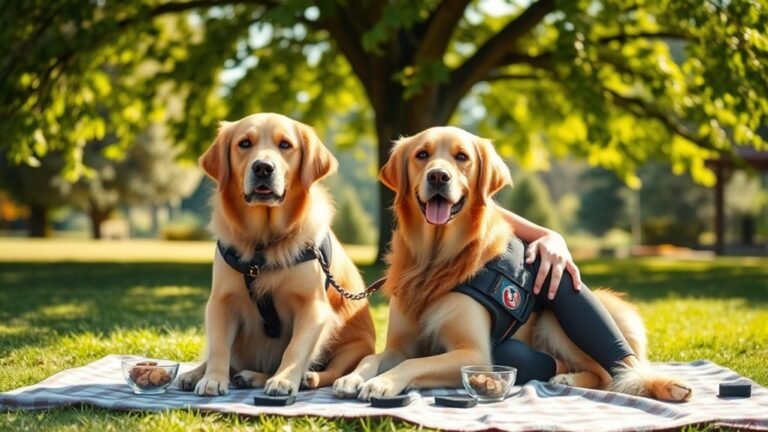Six Types of Dog Growling Explained
Understanding your dog's growls is important. Each type of growl can tell you something special about how your dog feels. These sounds can show happiness, fear, or even pain. By learning about the different kinds of growls, like greeting growls, playful growls, and warning growls, you can connect better with your dog.
Here are the main types of growls:
- Greeting Growls: These are happy sounds. Your dog might growl when they see you after a long day. It's their way of saying "I'm excited to see you!"
- Playful Growls: When your dog is having fun, they might growl while playing. This growl means they are enjoying themselves and want to keep playing.
- Warning Growls: If your dog feels scared or threatened, they might growl to warn others. This growl is serious. It shows they want to protect themselves or their space.
- Fearful Growls: A fearful growl can happen when your dog feels anxious or scared. This is a sign that they need comfort or help.
- Pain-related Growls: If your dog is in pain, they may growl as a way to express discomfort. This growl is important and often needs your attention.
The more you learn to recognize these different growls, the better you can understand your dog's feelings. This can make your bond even stronger. Each growl is like a little message from your furry friend. Listen closely, and you'll become the best dog communicator!
Key Takeaways
Here's a simple guide to understanding dog growls. Each growl has a different meaning that helps us know how our dogs are feeling.
- Greeting Growls: These growls show that your dog is happy and excited to see you. They want to play and spend time with you.
- Playful Growls: You hear these growls when your dog is having fun. They often make this sound during games like fetch or tug-of-war.
- Warning Growls: This growl means your dog feels scared or uncomfortable. It usually happens when a stranger comes too close to their space.
- Fearful Growls: When your dog is anxious or scared, they might growl in fear. Loud noises or new situations can cause this.
- Pain-Related Growls: If your dog is hurt or uncomfortable, they may growl. If you notice this happening often, it's best to visit the vet.
By paying attention to these growls, you can better understand your dog's feelings and needs.
Greeting Growls
Greeting growls are sounds dogs make when they're happy and excited to see you or other dogs.
These growls show that they want to play and be friendly. When your dog greets you with a growl, they usually wag their tail and have a relaxed body. Their ears might be up, and their body feels loose.
Understanding these greeting growls helps you connect better with your dog. You can tell they're feeling happy and want to interact. When you respond positively, it encourages your dog to feel good and socialize.
This builds a sense of belonging not just for your dog, but also for their dog friends.
Playful Growls
Dogs show their feelings with different sounds, and playful growls are a fun way to tell they're happy during playtime. These growls act like friendly signals, saying your dog is in a good mood.
You might hear playful growls in these situations:
- Chasing a ball – Your dog gets really excited, and the growl makes playtime even more fun.
- Wrestling with friends – The growl keeps the fun going and shows your dog is ready to play more.
- Playing tug-of-war – The playful growl adds to the thrill of the game.
- During fetch games – It shows how much your dog loves playing and keeps the energy high.
Understanding these happy sounds can help you connect with your furry friend even better.
Enjoy the playtime and those joyful growls!
Warning Growls
Warning growls are important sounds that show your dog feels scared or uncomfortable. When your dog growls, it's often telling others to stay away. This can happen if someone comes too close to your dog's space, like a stranger at the door or another dog at the park.
These growls mean your dog wants to protect their home or territory. Recognizing these sounds is key to keeping both you and your dog safe.
When you hear your dog growling, it's a sign to pay attention. You can help your dog feel better and avoid problems by understanding their signals.
This can make your bond stronger and help both of you feel more at ease.
Fearful Growls
Fearful growls from your dog can mean more than just being grumpy. These growls show that your dog is scared or anxious. Knowing what makes your dog growl out of fear can help you understand how they feel.
Here are some common things that might make your dog growl in fear:
- Loud noises – Sounds like thunder or fireworks can be very scary for dogs.
- Strangers coming close – New people might make your dog feel threatened.
- Unusual objects – Items they don't recognize can cause fear and lead to growling.
- Tight spaces – Being in a cramped area can make your dog anxious and lead to fearful sounds.
When your dog growls out of fear, it's important to listen. Understanding their feelings helps you keep them safe and happy.
Pain-Related Growls
Dogs use growls to tell us how they feel. If your dog growls when you touch them or come close, they might be in pain. It's important to notice this because it can mean they've an injury or are feeling uncomfortable.
When you hear your dog growling, pay attention to their body. Look for signs like limping, licking a specific spot, or not wanting to play. These signs can help you understand if your dog is hurting.
If you see these signs, it's best to take your dog to the vet. They can check for any problems and suggest treatment to help your pet feel better.
Frequently Asked Questions
Can Growling Indicate a Dog Is Happy or Content?
Growling can show how a dog feels. When a dog growls happily, it means they are excited. This type of growl often happens during playtime or when they see something they like. On the other hand, a soft growl can mean a dog is relaxed and comfortable.
How Can I Differentiate Between Growling Types?
To tell the difference between growls, pay attention to the situation and your dog's body language. Growls can mean different things. A low, rumbling growl usually shows that your dog feels uncomfortable. If you hear a higher-pitched growl, it might mean your dog is excited or wants to play.
Watch how your dog stands or moves too. Their tail, ears, and face can give you clues about what they are feeling. By observing these signs, you can understand your dog's growls better.
What Should I Do if My Dog Growls?
If your dog growls, stay calm. Remove anything that might be causing the growl. Look for what made your dog growl. It could be a person, another animal, or a loud noise.
Give your dog space if needed. After that, use treats or praise to reward good behavior. This helps your dog learn to trust you and feel safe.
Talk to your dog in a soft voice. This makes your dog feel more relaxed. Remember, growling is your dog's way of talking. Listening to them is important.
Does Breed Affect a Dog's Growling Behavior?
Yes, a dog's breed can influence how it growls. Different breeds have their own unique traits. Some dogs tend to growl more than others. Knowing these traits can help you understand your dog's growling better and respond to it in the right way. This will make it easier for you to handle your dog in different situations.
Are There Signs Growling Is Escalating to Aggression?
Look for signs when growling might lead to aggression. Signs like a stiff body, showing teeth, or strong staring can show your dog is upset. It's important to see these signs early. This helps keep you safe and makes sure you and your dog stay happy together. Pay attention!







